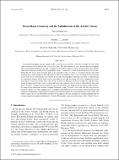| dc.contributor.author | Nilsson, Johan | |
| dc.contributor.author | Langen, Peter L. | |
| dc.contributor.author | Ferreira, David | |
| dc.contributor.author | Marshall, John C | |
| dc.date.accessioned | 2014-06-13T18:49:24Z | |
| dc.date.available | 2014-06-13T18:49:24Z | |
| dc.date.issued | 2013-08 | |
| dc.date.submitted | 2013-02 | |
| dc.identifier.issn | 0894-8755 | |
| dc.identifier.issn | 1520-0442 | |
| dc.identifier.uri | http://hdl.handle.net/1721.1/87784 | |
| dc.description.abstract | A coupled atmosphere–sea ice–ocean model is used in an aqua-planet setting to examine the role of the basin geometry for the climate and ocean circulation. The basin geometry has a present-day-like topology with two idealized northern basins and a circumpolar ocean in the south. A suite of experiments is described in which the southward extents of the two (gridpoint wide) “continents” and the basin widths have been varied. When the two basins have identical shapes, the coupled model can attain a symmetric climate state with northern deep-water formation in both basins as well as asymmetric states, where the deep-water formation occurs only in one of the basins and Atlantic–Pacific-like hydrographic differences develop. A difference in the southward extents of the land barriers can enhance as well as reduce the zonal asymmetries of the atmosphere–ocean circulation. This arises from an interplay between the basin boundaries and the wind-driven Sverdrup circulation, which controls the interbasin exchange of heat and salt. Remarkably, when the short “African” continent is located near or equatorward of the zero wind line in the Southern Hemisphere, the deep-water formation becomes uniquely localized to the “Atlantic”-like basin with the long western boundary. In this case, the salinification is accomplished primarily by a westward wind-routed interbasin salt transport. Furthermore, experiments using geometries with asymmetries in both continental extents and basin widths suggest that in the World Ocean these two fundamental basin asymmetries should independently be strong enough for uniquely localizing the Northern Hemisphere deep-water formation to the Atlantic Ocean. | en_US |
| dc.description.sponsorship | National Science Foundation (U.S.). Physical Oceanography Program | en_US |
| dc.language.iso | en_US | |
| dc.publisher | American Meteorological Society | en_US |
| dc.relation.isversionof | http://dx.doi.org/10.1175/jcli-d-12-00358.1 | en_US |
| dc.title | Ocean Basin Geometry and the Salinification of the Atlantic Ocean | en_US |
| dc.type | Article | en_US |
| dc.identifier.citation | Nilsson, Johan, Peter L. Langen, David Ferreira, and John Marshall. “Ocean Basin Geometry and the Salinification of the Atlantic Ocean.” J. Climate 26, no. 16 (August 2013): 6163–6184. © 2013 American Meteorological Society | en_US |
| dc.contributor.department | Massachusetts Institute of Technology. Department of Earth, Atmospheric, and Planetary Sciences | en_US |
| dc.contributor.mitauthor | Ferreira, David | en_US |
| dc.contributor.mitauthor | Marshall, John C. | en_US |
| dc.relation.journal | Journal of Climate | en_US |
| dc.eprint.version | Author's final manuscript | en_US |
| dc.type.uri | http://purl.org/eprint/type/JournalArticle | en_US |
| eprint.status | http://purl.org/eprint/status/PeerReviewed | en_US |
| dspace.orderedauthors | Nilsson, Johan; Langen, Peter L.; Ferreira, David; Marshall, John | en_US |
| dc.identifier.orcid | https://orcid.org/0000-0001-9230-3591 | |
| mit.license | OPEN_ACCESS_POLICY | en_US |
| mit.metadata.status | Complete | |
